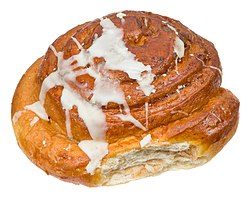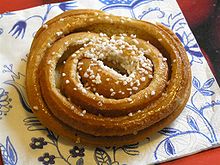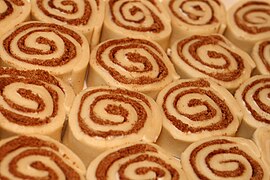Cinnamon roll: Difference between revisions
m Robot - Removing category Germanic cuisine per CFD at Wikipedia:Categories for discussion/Log/2019 December 26. |
→Gallery: Added content Tags: Mobile edit Mobile web edit |
||
| Line 54: | Line 54: | ||
File:Cinnamon roll.jpg|A cinnamon roll in Alexandria, Egypt |
File:Cinnamon roll.jpg|A cinnamon roll in Alexandria, Egypt |
||
</gallery> |
</gallery> |
||
===References in popular culture=== |
|||
A cinnamon bun can be picked up in the 2015 horror game [[Fran Bow]] and drugged to knock out the night guard. |
|||
==See also== |
==See also== |
||
Revision as of 01:54, 17 January 2020
 A cinnamon roll with white icing | |
| Alternative names | Cinnamon bun, cinnamon swirl, cinnamon Danish, cinnamon snail |
|---|---|
| Type | Sweet roll |
| Place of origin | Sweden and Denmark |
| Main ingredients | flour, cinnamon, sugar, and butter |
A cinnamon roll (also cinnamon bun, cinnamon swirl, cinnamon Danish and cinnamon snail)[1][2] is a sweet roll served commonly in Northern Europe (mainly in Scandinavia) and North America. In Sweden it is called kanelbulle, in Denmark it is known as kanelsnegl (cinnamon snail), in Norway it is known as skillingsboller, and in Finland it is known as korvapuusti (see Origins) and is a form of wienerbrød ('Vienna Bread'). Its main ingredients are flour, cinnamon, sugar, and butter, which provide a robust and sweet flavor.
Pastry

A cinnamon roll consists of a rolled sheet of yeast-leavened dough onto which a cinnamon and sugar mixture (and raisins or other ingredients in some cases) is sprinkled over a thin coat of butter. The dough is then rolled, cut into individual portions, and baked or deep fried.
Origins
In Sweden, the country of its presumed origin, the cinnamon roll takes the name of kanelbulle (lit. ''cinnamon bun''). Since 1999,[3][4] October 4 has been promoted as 'kanelbullens dag' (Cinnamon Roll Day).[5][6] Swedish kanelbulle dough typically also contains cardamom (powder or buds), giving it a distinctive flavour.
The size of a cinnamon roll varies from place to place, but many vendors supply a smaller size about 5 centimeters (2.0 in) in diameter and a larger size about 10 cm (3.9 in) to a side. The larger variety can be found in Finland, called korvapuusti (lit. 'a 'cuff on the ear'', fig. "pulling someone's ear for disciplining"), where it can be up to 20 cm (7.9 in) in diameter and weigh up to 200 g (7.1 oz).[7] Haga, an area in Gothenburg, Sweden, is well known for their very large cinnamon rolls. These cinnamon rolls are called hagabullar or 'Queen of the kitchen'. Hagabullar are usually 30 centimeters (12 in) or more in diameter and are, despite their size, not considered a communal roll. Each person usually orders one each.[8]
National variations
In Northern Europe, nib sugar is usually used with a glaze instead of icing. The Finnish bostonkakku ('Boston cake') is a cake made by baking cinnamon rolls in a round cake pan instead of baking them separately, so that they stick together to form a large, round cake.[9]
A German variety, which closely follows the form of the Scandinavian pastry, originating in Hamburg and its surroundings is the Franzbrötchen, a cinnamon pastry inspired by the non-cinnamon French croissant.
The British version is an approximation of the Danish butter type and is readily available in cafes, supermarkets, and bakeries across the UK.
American cinnamon rolls are frequently topped with icing (usually confectioners' sugar-based) and are sometimes fried, finished with glaze, and served as a variation of a raised donut. There are also regional variations: in the American Midwest, especially Kansas, cinnamon rolls may be dipped or smothered in chili.[10]
In Canada, they are known as cinnamon buns. They are usually self-glazed and not iced, nor do they usually have raisins.[11][12] They can have so much cinnamon that they are spicy and hot to the taste.
Cinnamon roll traditions
In Sweden, cinnamon rolls are traditionally enjoyed during a coffee break, or fika which is a get together with friends. National Cinnamon Bun Day (Kanelbullens dag) is observed on October 4.[1]
In North America, it is commonly eaten for breakfast or dessert. When eaten for a breakfast in the U.S., it may be served with cream cheese.[13]
Gallery
-
A Finnish korvapuusti (lit. a cuff on the ear)
-
A Danish kanelsnegl
-
A Norwegian skillingsbolle
-
A 'loaf' of raw cinnamon roll dough being cut into individual rolls prior to being baked
-
Uncooked cinnamon roll buns
-
A cinnamon roll in Alexandria, Egypt
References in popular culture
A cinnamon bun can be picked up in the 2015 horror game Fran Bow and drugged to knock out the night guard.
See also
- Cinnabon – Bakery chain known for cinnamon rolls
- Chelsea bun – Confectionery made using a similar process
- Sweet roll
- Tahini roll
- Fig roll
- Tahinopita
- List of buns
References
- ^ The Free Dictionary. "cinnamon snail". Retrieved April 17, 2013.
- ^ Carlson, Jen. "Why The Cinnamon Snail Vegan Food Truck Is The Best Food Truck In Town". The Gothamist. Archived from the original on April 7, 2013. Retrieved April 16, 2013.
- ^ "Om oss". Hembakningsrådet (in Swedish). September 12, 2014. Retrieved October 4, 2017.
- ^ "Så blev kanelbullen det mest svenska av alla bakverk - DN.SE". DN.SE (in Swedish). October 4, 2017. Retrieved October 4, 2017.
- ^ "Kanelbullens Dag 4 Oktober". Kanelbullensdag.se. Retrieved June 4, 2010.
- ^ "Kanelbullar". Sweden.se. Retrieved March 25, 2013.
- ^ Korvapuusti in Finland Archived February 26, 2008, at the Wayback Machine
- ^ "Kanelbullar.se". Kanelbullar.se. Retrieved July 17, 2016.
- ^ "Boston cake". Saunalahti.fi. Retrieved November 18, 2012.
- ^ "Chili and Cinnamon Rolls, is this a Kansas Thing?". Retrieved October 5, 2017.
- ^ Tagliafierro, Angelina. "UBC Cinnamon Bun". Retrieved January 12, 2019.
- ^ Lugonja, Valerie (December 19, 2016). "Helen McKinney's Canadian Prairie Homemade Cinnamon Buns". Retrieved January 12, 2019.
- ^ "Screamin' Cinnamon Rolls With Cream Cheese Frosting". Food.com. Retrieved July 20, 2016.






